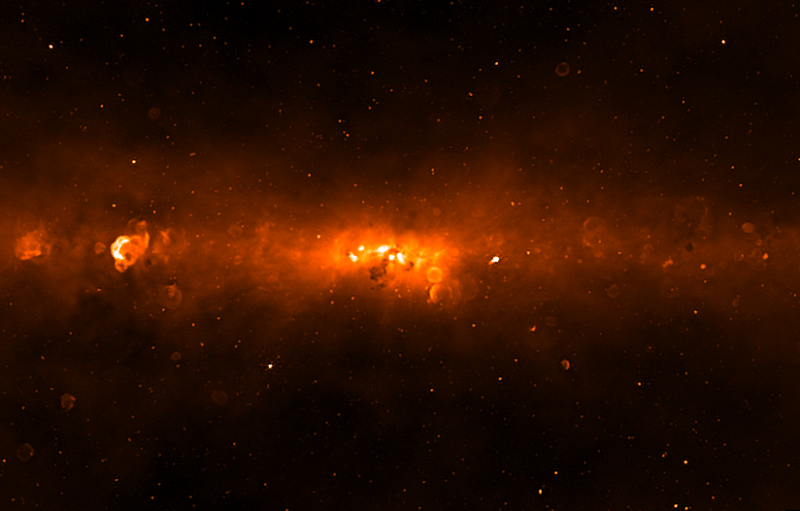This image shows the centre of the Milky Way as seen by the Galactic Centre Molecular Line Survey. Credit: Chenoa Tremblay (ICRAR-Curtin)
Astronomers have used an Australian radio telescope to observe molecular signatures from stars, gas and dust in our galaxy, which could lead to the detection of complex molecules that are precursors to life.
Using the Murchison Widefield Array (MWA), a radio telescope located in the Murchison region of Western Australia, the team successfully detected two molecules called the mercapto radical (SH) and nitric oxide (NO).
"The molecular transitions we saw are from slow variable stars—stars at the end of their lives that are becoming unstable," said Chenoa Tremblay from the International Centre for Radio Astronomy Research (ICRAR) and Curtin University.
"One of the unique aspects of this survey is that until now, no one has ever reported detections of molecules within the 70-300MHz frequency range of the MWA and this is the widest field-of-view molecular survey of the Milky Way ever published."
Since the 1980s, frequencies greater than 80GHz have been used for this type of work due to the freedom from radio frequency interference emitted by our mobile phones, televisions and orbiting satellites. But the extreme "radio quietness" of the Murchison Radio-astronomy Observatory, where the telescope is located, allows astronomers to study molecular signatures from stars and star-forming regions at lower frequencies.
"Before this study, the mercapto radical had only been seen twice before at infrared wavelengths, in a different part of the electromagnetic spectrum," said Dr Maria Cunningham from the University of New South Wales.
"This shows that molecules are emitting photons detectable around 100MHz and we can detect these molecular signatures using the MWA—it's very exciting for us," she said.
Following on from the pilot study, a survey of the Orion region is now in progress, again using the MWA, in the frequency range of 99-270MHz. The Orion nebula is a chemical-rich environment and one of the closest star-forming regions to Earth. The aim is to detect more chemical tracers in stars, compare these regions to the observations from the Galactic Centre pilot region and to better understand the emission mechanisms of these molecules.
"This new technique paves the way for deeper surveys that can probe the Milky Way and other galaxies in search of molecular precursors to life," said Tremblay.
"We might even discover signatures from long chain amino acids in the cold gas environments we're observing—which is where they are likely to be most stable."
More information: Chenoa D. Tremblay et al. A First Look for Molecules between 103 and 133 MHz using the Murchison Widefield Array, Monthly Notices of the Royal Astronomical Society (2017). DOI: 10.1093/mnras/stx1838
Journal information: Monthly Notices of the Royal Astronomical Society
Provided by International Centre for Radio Astronomy Research
























